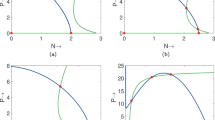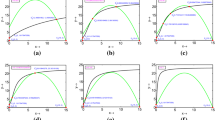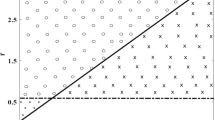Abstract
In a more realistic scenario, we posit that certain predators engage in cooperative hunting of prey, all the while competing with other predators and occasionally causing fatal harm to one another. It is assumed that prey employ various strategies, including camouflage and concealment, to evade predators. The competition among the predators is considered the bifurcation parameter to analyze the equilibrium states and their characteristics, encompassing phenomena like saddle-node bifurcation, Hopf bifurcation, and the Hydra effect. Our primary focus is to examine how the dynamics of the system are influenced by prey seeking shelter and predator cooperation. Prey shelter effectively conceals a segment of its population from predators, reducing the critical point for outbreak occurrence and heightening vulnerability to outbreaks at lower prey population levels. The addition of cooperation reduces the peak predator population, necessitating increased competition and altering equilibrium thresholds.






Similar content being viewed by others
Data Availability
No data associated in the manuscript.
References
V. Volterra, Lecons sur la theorie Mathematique de la Lutte pour la vie Paris: Gauthier-Villars (1931)
P. Leslie, Some further notes on the use of matrices in population mathematic. Biometrica 35, 213–245 (1948)
P. Leslie, J.C. Gower, The properties of a stochastic model for the predator-prey type of interaction between two species. Biometrika 47, 219–234 (1960)
M. Martelli, Discrete Dynamical Systems and Chaos [Pitman Monographs and Surveys in Pure and Applied Mathematics, Vol. 62]. New York: Longman (1992)
S.H. Strogatz, Non-linear Dynamics and Chaos, CRC Press, (2018)
M.L. Rosenzweig, R.H. MacArthur, Graphical representation and stability conditions of predator–prey interactions. Am. Nat. 97, 209–223 (1963)
C.S. Holling, The functional response of predator to prey density and its role in mimicry and population regulation. Mem. Entomol. Soc. Canada 45, 1–60 (1965)
A.D. Basykin, The Volterra system the Mikhaelis–Mente equation, Problems of Mathematical Genetics (Novosibirsk SO AN SSSR) 103, (in Russian) (1974)
A.D. Bazykin, Structural and dynamic stability of model predator prey systems. IIASA Research Memorandum (1976)
H.A. Lauwerier, Two-dimensional iterative maps. In Chaos, A.V. Holden (Ed), Princeton University Press, Princeton, NJ, 58–97 (1986)
B. Krauskopf, A.I. Khibnik, A.D. Bazykin, Nonlinear Dynamics of interacting Populations World Scientific series on nonlinear science (Series A Monographs and treatises, World Scientific, Year, 1998)
S.L. Lima, Nonlethal effects in the ecology of predator–prey interactions. Bioscience 48(1), 25–34 (1998)
S. Creel, D. Christianson, Relationships between direct predation and risk effects. Trends Ecol. Evol. 23(1), 194–201 (2008)
S.L. Lima, Predators and the breeding bird: behavioral and reproductive flexibility under the risk of predation. Biol. Rev. 84(1), 485–513 (2010)
W. Cresswell, Predation in bird populations. J. Ornithol. 152(1), 251–263 (2011)
L.Y. Zanette, M. Clinchy, Perceived predation risk reduces the number of offspring songbirds produce per year. Science 334(1), 1398–1401 (2011)
X. Wang, L. Zanette, X. Zou, Modelling the fear effect in predator–prey interactions. J. Math. Biol. 73(1), 1–26 (2016)
X. Wang, X. Zou, Modeling the fear effect in predator-prey interactions with adaptive avoidance of predators. Bull. Math. Biol. 79(1), 1–355 (2017)
C.B. Huffaker, C.E. Kennett, Experimental studies on predation: predation and cyclamen-mite populations on strawberries in California. Hilgardia 26, 191–222 (1956)
M. Van de Vrie, Apple. In Spider Mites: Their Biology, Natural Enemies and Control, W. Helle and M. W. Sabelis (Eds), pp. 311-325. World Crop Pests Vol. 1B. Amsterdam: Elsevier (1985)
E. Post, R.O. Peterson, N.C. Stenseth, B.E. McLaren, Ecosystem consequences of wolf behavioural response to climate. Nature 401, 905–907 (1999)
B.L. Peckarsky, P.A. Abrams, D.I. Bolnick, L.M. Dill, J.H. Grabowski, B. Luttbeg, J.L. Orrock, S.D. Peacor, E.L. Preisser, O.J. Schmitz, G.C. Trussell, Revisiting the classics: considering nonconsumptive effects in textbook examples of predator–prey interactions. Ecology 89(9), 2416–2425 (2008)
E. Gonzalez-Olivares, R. Ramos-Jiliberto, Dynamic consequences of prey refuges in a simple model system: more prey, fewer predators and enhanced stability. Ecol. Model. 166, 135–146 (2003)
P.A. Abrams, Measuring the impact of dynamic antipredator traits on predator–prey-resource interactions. Ecology 89, 1640–1649 (2008)
S. Chakraborty, S. Bhattacharya, U. Feudel, J. Chattopadhyay, The role of avoidance by zooplankton for survival and dominance of toxic phytoplankton. Ecol. Compl. 11, 144–153 (2012)
T.W. Anderson, Predator responses prey refuges and density-dependent mortality of a marine fish. Ecology 82, 245–257 (2001)
A.A. Berryman, B.A. Hawkins, The refuge as an integrating concept in ecology and evolution. Oikos 115, 192–196 (2006)
T.K. Kar, Stability analysis of a prey–predator model incorporating a prey refuge. Commun. Nonlinear Sci. Numer. Simul. 10, 681–691 (2005)
W. Ko, K. Ryu, Qualitative analysis of a predator–prey model with Holling type II functional response incorporating a prey refuge. J. Differ. Equ. 231, 534–550 (2006)
H. Zhang, Y. Cai, S. Fu, W. Wang Impact of the fear effect in a prey–predator model incorporating a prey refuge. Appl. Math. Comput. 356 328–337 (2019)
S. Pal, F. Al Basir, S. Ray, Impact of cooperation and intra-specific competition of prey on the stability of prey–predator models with refuge. Math. Comput. Appl. 28, 88 (2023). https://doi.org/10.3390/mca28040088
L. Chen, F. Chen, L. Chen, Qualitative analysis of predator–prey model with Holling type II functional response incorporating a constant prey refuge. Nonlinear Anal. Real World Appl. 11, 246–252 (2010)
R. Cressman, J. Garay, A predator–prey refuge system: evolutionary stability in ecological systems. Theor. Popul. Biol. 76, 248–257 (2009)
C. Packer, L. Ruttan, The evolution of cooperative hunting. Am. Nat. 132, 159–198 (1988)
D.W. Macdonald, The ecology of carnivore social behaviour. Nature 301, 379–384 (1983)
M.L. Luhrs, M. Dammhahn, An unusual case of cooperative hunting in a solitary carnivore. J. Ethol. 28, 379–383 (2010). https://doi.org/10.1007/s10164-009-0190-8
S. Creel, N.M. Creel, Communal hunting and pack size in African wild dogs. Lycaon pictus. Anim. Behav. 50, 1325–1339 (1985)
P.A. Schmidt, L.D. Mech, Wolf pack size and food acquisition. Am. Nat. 150, 513–517 (1997)
C. Packer, D. Scheel, A.E. Pusey, Why lions form groups: food is not enough. Am. Nat. 136, 1–19 (1990)
D. Scheel, C. Packer, Group hunting behaviour of lions: a search for cooperation. Anim. Behav. 41, 697–709 (1991)
P.E. Stander, Cooperative hunting in lions: the role of the individual. Behav. Ecol. Sociobiol. 29, 445–454 (1992)
C. Boesch, Cooperative hunting in wild chimpanzees. Anim. Behav. 48, 653–667 (1994)
G.W. Uetz, Foraging strategies of spiders. Trends Ecol. Evol. 7, 155–159 (1992)
D.P. Hector, Cooperative hunting and its relationship to foraging success and prey size in an avian predator. Ethology 73, 247–257 (1986)
M.W. Moffett, Foraging dynamics in the group-hunting myrmicine ant, pheidologeton diversus. J. Insect. Behav. 1, 309–331 (1988)
J.C. Bednarz, Cooperative hunting Harris’ hawks (Parabuteo unicinctus). Science 239, 1525–1527 (1988)
T. Pitcher, A. Magurran, I. Winfield, Fish in larger shoals find food faster. Behav. Ecol. Sociobiol. 10, 149–151 (1982)
R.D. Estes, J. Goddard, Prey selection and hunting behavior of the African wild dog. J. Wildl. Manage. 31, 52–70 (1967). https://doi.org/10.2307/1249030
J.A. Vucetich, R.O. Peterson, T.A. Waite, Raven scavenging favours group foraging in wolves. Anim. Behav. 67, 1117–1126 (2004)
M.T. Alves, F.M. Hilker, Hunting cooperation and Allee effects in predators. J. Theoret. Biol. 419, 13–22 (2017)
K. Ryu, and W. Ko, Asymptotic behavior of positive solutions to a predator–prey elliptic system with strong hunting cooperation in predators, Physica A (531), 121726 (2019)
E.M. Takyi, C. Ohanian, M. Cathcart, N. Kumar, Dynamical analysis of a predator–prey system with prey vigilance and hunting cooperation in predators. Math Biosci. Eng. 21(2), 2768–2786 (2024). https://doi.org/10.3934/mbe.2024123
R.M. Simkins, M.C. Belk, No evidence of nonlinear effects of predator density, refuge availability, or body size of prey on prey mortality rates. Ecol. Evol. 16, 6119–6124 (2017). https://doi.org/10.1002/ece3.3183
E. González-Olivares , J. Cabrera-Villegas, F. Córdova-Lepe, A. Rojas-Palma, Competition among Predators and Allee Effect on Prey, Their Influence on a Gause-Type Predation Model , Mathematical Problems in Engineering Volume 2019, Article ID 3967408, 19 pages https://doi.org/10.1155/2019/3967408
L. Berec, Impacts of foraging facilitation among predators on predator–prey dynamics. Bull. Math. Biol. 72(1), 94–121 (2010)
G.T. Skalski, J.F. Gilliam, Functional responses with predator interference: viable alternatives to the Holling type II model. Ecology 82(11), 3083–3092 (2001)
J.R. Beddington, Mutual interference between parasites or predators and its effect on searching efficiency. J. Anim. Ecol. 44(1), 331–340 (1975)
D.L. DeAngelis, R.A. Goldstein, R.V. O’Neill, A model for trophic interaction. Ecology 56, 881–892 (1975)
P.H. Crowley, E.K. Martin, Functional responses and interference within and between year classes of a dragonfly population. J. N. Am. Benthol. Soc. 8, 211–221 (1998)
Y. Kuang, W.F. Fagan, I. Loladze, Biodiversity, habitat area, resource growth rate and interference competition. Bull. Math. Biol. 65, 497–518 (2003)
H. Berestycki, A. Zilio, Predator–Prey models with competition: the emergence of territoriality. Am. Nat. 193(3), 436–446 (2019)
L.A. Kalyakin, Asymptotics of Andronov–Hopf Dynamic Bifurcations, J. Math. Sci. 260(6) (2022)
D.L. Lack, The Natural Regulation of Animal Numbers (Clarendon, Oxford, 1954), pp.212–217
R.M. May, Limit cycles in predator–prey communities. Science 177, 900–902 (1972). https://doi.org/10.1126/science.177.4052.900
B. Blasius, L. Rudolf, G. Weithoff, U. Gaedke, G.F. Fussmann, Long-term cyclic persistence in an experimental predator–prey system. Nature 577(7789), 226–230 (2019). https://doi.org/10.1038/s41586-019-1857-0
B. Tang, Y. Xiao, Bifurcation analysis of a predator-prey model with anti-predator behaviour. Chaos Solitons Fract. 70, 58–68 (2015)
D. Sen, S. Ghorai, M. Banerjee, A., Morozov, Bifurcation analysis of the predator–prey model with the Allee effect in the predator. J. Math. Biol. 84:7 (2022) https://doi.org/10.1007/s00285-021-01707-x
N. Wang, M. Zhao, H. Yu, C. Dai, B. Wang, and P. Wang, Bifurcation Behavior Analysis in a Predator-Prey Model Hindawi Publishing Corporation Discrete Dynamics in Nature and Society, Volume 2016, Article ID 3565316, 11 pages https://doi.org/10.1155/2016/3565316
H. Chen, C. Zhang, Bifurcations and hydra effects in a reaction–diffusion pradator–prey model with Holling II functional response. J.Appl. Anal. Comput. 13(1), 424–444 (2023)
A. Peter, AbramsWhen does greater mortality increase population size? The long history and diverse mechanisms underlying the hydra effect. Ecol. Lett. 12, 462–474 (2009)
A. Schroder, L. Persson, A.M.D. Roos, Culling experiments demonstrate size-class specific biomass increases with mortality. Proc. Natl. Acad. Sci. USA 106(8), 2671–2676 (2009)
A. Schroder, A. van Leeuwen, T.C. Cameron, When less is more: positive population-level effects of mortality. Trends Ecol. Evol. 29(11), 614–624 (2014)
M. Lu, C. Xiang, J. Huang, H. Wang, Bifurcations in the diffusive Bazykin model. J. Differ. Equ. 323, 280–311 (2022). https://doi.org/10.1016/j.jde.2022.03.039
M.H. Cortez, P.A. Abrams, Hydra effects in stable communities and their implications for system dynamics. Ecology 97(5), 1135–1145 (2016)
M. Sieber, F.M. Hilker, The hydra effect in predator–prey models. J. Math. Biol. 64(1–2), 341–360 (2012). https://doi.org/10.1007/s00285-011-0416-6
P.A. Abrams, What are hydra effects? A response to Schroder et al., Trends Ecol. Evol. 30(4), 179–180 (2015)
W.E. Ricker, Stock and recruitment. J. Fish. Res. Board Can. 11, 559–623 (1954)
R.A. Pratama, O. Dadi, A.M.A. Siddik, Kasbawati, Hydra effects predator–prey Bazykin’s model with stagestructure and intraspecific for predator. J. Matematika 5(3), 279–288 (2022)
L.B. Slobodkin, Prudent predation does not require group selection. Am. Nat. 108, 665–678 (1974)
R.D. Holt, Food webs in space: on the interplay of dynamic instability and spatial processes. Ecol. Res. 17, 261–273 (2002)
M. Danca, S. Codreanu, B. Bako\(^{\prime }\), Detailed Analysis of a Nonlinear prey–predator Model. J. Biol. Phys. 23, 11–20 (1997)
Y. Xiao, L. Chen, A ratio-dependent predator–prey model with disease in the prey. Appl. Math. Comput. 131, 397–414 (2002)
F. Wu, Y. Jiao, Stability and Hopf bifurcation of a predator–prey model. Ecology, 129, (2019) https://doi.org/10.1186/s13661-019-1242-9
K.D. Prasad, B.S.R.V. Prasad, Qualitative analysis of additional food provided predator-prey system with anti-predator behaviour in prey. Nonlinear Dyn. (2019). https://doi.org/10.1007/s11071-019-04883-0
M. Shivam, T. Kumar, S. Singh, Chauhan, positive effect of predator’s mortality in predator–prey system via turing patterns. Braz. J. Phys. 52, 159 (2022)
W. Zhang, D. Jin, R. Yang, Hopf bifurcation in a predator–prey model with memory effect in predator and anti-predator behaviour in prey. Mathematics 11, 556 (2023)
S. Biswas, L.T. Bhutiab and T.P. Kar Transient and asymptotic dynamics of Bazykin’s prey–predator model on managing reactivity, resilience, and maximum sustainable yield, Eur. Phys. J. Plus, 138, 256 (2023) https://doi.org/10.1140/epjp/s13360-023-03824-6
C. Cosner, D.L. DeAngelis, J.S. Ault, D.B. Olson, Effects of spatial grouping on the functional response of predators. Theor. Popul. Biol. 56, 65–75 (1999)
J. Duarte, C. Januário, N. Martins, J. Sardanyés, Chaos and crises in a model for cooperative hunting: a symbolic dynamics approach. Chaos 19, 043102 (2009)
S. Pal, N. Pal, S. Samanta, J. Chattopadhyay, Fear effect in prey and hunting cooperation among predators in a Leslie–Gower model. Math. Biosci. Eng. 16, 5146–5179 (2019)
Y. Du, B. Niu, J. Wei, A predator–prey model with cooperative hunting in the predator and group defense in the prey. Discrete Cont. Dyn.-B. 27, 5845–5881 (2022)
K.A. Abbakar, Y. Yang, A. Mohamed, S. Xia, M.M. Abkar, O.B.E. Hassan, Stability analysis and Hopf bifurcation for ODE system of predator–prey model with mutual interference. Appl. Math. 12, 793–802 (2021)
P.D. Adhikary, S. Mukherjee, B. Ghosh, Bifurcations and hydra effects in Bazykin’s predator–prey model. Theor. Popul. Biol. 140, 44–53 (2021)
T. Ma, Z. Meng, A.K. Alzahrani, Turing instability and Hopf bifurcation induced by prey refuge in a diffusive predator–prey system with stage structure and anti-predation. Eur. Phys. J. Plus (138), 624 (2023)
A.K. Lasunskii, Equilibria of a nonautonomous Lotka–Volterra model with shelter for the prey. Differ. Equ. 45, 460–463 (2007)
M. Rayungsari, A. Sryanto, W.M. Kusumawinahyu, Dynamical analysis of a predator–prey model incorporating predator cannibalism and refuge. Axioms 11, 116 (2022)
T.V. Karamysheva, N.A. Magnitskii, Transition to diffusion chaos in a model of a ‘Predator–Prey’ system with a lower threshold for the prey population. Differ. Equ. 56, 671–675 (2020)
D. Bai, J. Tang, Global Dynamics of a Predator-Prey System with Cooperative Hunting. Appl. Sci., 13, 8178 (2023). https://doi.org/10.3390/app13148178
M.S. Surendar, M. Sambath, K. Balachandran and Y.-K. Ma, Qualitative analysis of a prey–predator model with prey refuge and intraspecific competition among predators. Bound. Value Problems 81, 2023 (2023) https://doi.org/10.1186/s13661-023-01771-w
J. Tong, \(b^2-4ac\) and \(b^2-3ac\). Math Gazzette 88, 511–513 (2004)
M. Bestehorn, Computational Physics, The MathWorks, Inc. (2023) http://dnb.dnb.de
Irving R. Epstein, John A. Pojman, An Introductions to Nonlinear Chemical Dynamics, Oscillations, Waves, Patterns, and Chaos (Oxford University Press, New York, 1998)
P.A. Abrams, H. Matsuda, The effect of adaptive change in prey on the dynamics of an exploited predator population. Can. J. Fish. Aquat. Sci. 62, 758–766 (2005)
P.A. Abrams, When does greater mortality increase population size? The long history and diverse mechanisms underlying the hydra effect. Ecol. Lett. 12, 462–474 (2009)
Acknowledgements
This study is performed under the Science Centre Project No. SGTBKC/2682, titled Pattern in Biological Systems, of the SGTB Khalsa College, University of Delhi, Delhi 110007, India.
Author information
Authors and Affiliations
Corresponding author
Ethics declarations
Conflict of interest
There are no conflict of interest.
Rights and permissions
Springer Nature or its licensor (e.g. a society or other partner) holds exclusive rights to this article under a publishing agreement with the author(s) or other rightsholder(s); author self-archiving of the accepted manuscript version of this article is solely governed by the terms of such publishing agreement and applicable law.
About this article
Cite this article
Singh, S.K., Chauhan, H., Vardhan, Y. et al. Prey–predator realities: unveiling competition, cooperation, and shelter dynamics. Eur. Phys. J. Plus 139, 392 (2024). https://doi.org/10.1140/epjp/s13360-024-05171-6
Received:
Accepted:
Published:
DOI: https://doi.org/10.1140/epjp/s13360-024-05171-6




